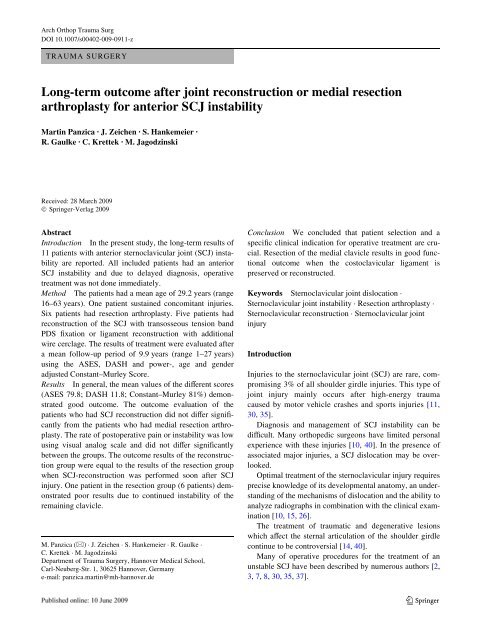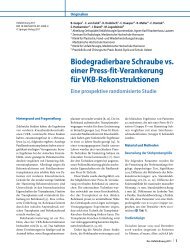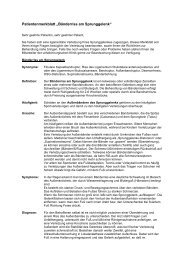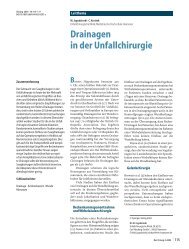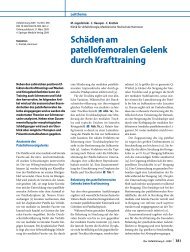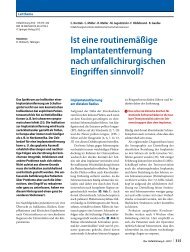Long-term outcome after joint reconstruction or ... - ResearchGate
Long-term outcome after joint reconstruction or ... - ResearchGate
Long-term outcome after joint reconstruction or ... - ResearchGate
Create successful ePaper yourself
Turn your PDF publications into a flip-book with our unique Google optimized e-Paper software.
Arch Orthop Trauma Surg<br />
DOI 10.1007/s00402-009-0911-z<br />
TRAUMA SURGERY<br />
<strong>Long</strong>-<strong>term</strong> <strong>outcome</strong> <strong>after</strong> <strong>joint</strong> <strong>reconstruction</strong> <strong>or</strong> medial resection<br />
arthroplasty f<strong>or</strong> anteri<strong>or</strong> SCJ instability<br />
Martin Panzica · J. Zeichen · S. Hankemeier ·<br />
R. Gaulke · C. Krettek · M. Jagodzinski<br />
Received: 28 March 2009<br />
© Springer-Verlag 2009<br />
Abstract<br />
Introduction In the present study, the long-<strong>term</strong> results of<br />
11 patients with anteri<strong>or</strong> sternoclavicular <strong>joint</strong> (SCJ) instability<br />
are rep<strong>or</strong>ted. All included patients had an anteri<strong>or</strong><br />
SCJ instability and due to delayed diagnosis, operative<br />
treatment was not done immediately.<br />
Method The patients had a mean age of 29.2 years (range<br />
16–63 years). One patient sustained concomitant injuries.<br />
Six patients had resection arthroplasty. Five patients had<br />
<strong>reconstruction</strong> of the SCJ with transosseous tension band<br />
PDS Wxation <strong>or</strong> ligament <strong>reconstruction</strong> with additional<br />
wire cerclage. The results of treatment were evaluated <strong>after</strong><br />
a mean follow-up period of 9.9 years (range 1–27 years)<br />
using the ASES, DASH and power-, age and gender<br />
adjusted Constant–Murley Sc<strong>or</strong>e.<br />
Results In general, the mean values of the diVerent sc<strong>or</strong>es<br />
(ASES 79.8; DASH 11.8; Constant–Murley 81%) demonstrated<br />
good <strong>outcome</strong>. The <strong>outcome</strong> evaluation of the<br />
patients who had SCJ <strong>reconstruction</strong> did not diVer signiWcantly<br />
from the patients who had medial resection arthroplasty.<br />
The rate of postoperative pain <strong>or</strong> instability was low<br />
using visual analog scale and did not diVer signiWcantly<br />
between the groups. The <strong>outcome</strong> results of the <strong>reconstruction</strong><br />
group were equal to the results of the resection group<br />
when SCJ-<strong>reconstruction</strong> was perf<strong>or</strong>med soon <strong>after</strong> SCJ<br />
injury. One patient in the resection group (6 patients) demonstrated<br />
po<strong>or</strong> results due to continued instability of the<br />
remaining clavicle.<br />
M. Panzica (&) · J. Zeichen · S. Hankemeier · R. Gaulke ·<br />
C. Krettek · M. Jagodzinski<br />
Department of Trauma Surgery, Hannover Medical School,<br />
Carl-Neuberg-Str. 1, 30625 Hannover, Germany<br />
e-mail: panzica.martin@mh-hannover.de<br />
Conclusion We concluded that patient selection and a<br />
speciWc clinical indication f<strong>or</strong> operative treatment are crucial.<br />
Resection of the medial clavicle results in good functional<br />
<strong>outcome</strong> when the costoclavicular ligament is<br />
preserved <strong>or</strong> reconstructed.<br />
Keyw<strong>or</strong>ds Sternoclavicular <strong>joint</strong> dislocation ·<br />
Sternoclavicular <strong>joint</strong> instability · Resection arthroplasty ·<br />
Sternoclavicular <strong>reconstruction</strong> · Sternoclavicular <strong>joint</strong><br />
injury<br />
Introduction<br />
Injuries to the sternoclavicular <strong>joint</strong> (SCJ) are rare, compromising<br />
3% of all shoulder girdle injuries. This type of<br />
<strong>joint</strong> injury mainly occurs <strong>after</strong> high-energy trauma<br />
caused by mot<strong>or</strong> vehicle crashes and sp<strong>or</strong>ts injuries [11,<br />
30, 35].<br />
Diagnosis and management of SCJ instability can be<br />
diYcult. Many <strong>or</strong>thopedic surgeons have limited personal<br />
experience with these injuries [10, 40]. In the presence of<br />
associated maj<strong>or</strong> injuries, a SCJ dislocation may be overlooked.<br />
Optimal treatment of the sternoclavicular injury requires<br />
precise knowledge of its developmental anatomy, an understanding<br />
of the mechanisms of dislocation and the ability to<br />
analyze radiographs in combination with the clinical examination<br />
[10, 15, 26].<br />
The treatment of traumatic and degenerative lesions<br />
which aVect the sternal articulation of the shoulder girdle<br />
continue to be controversial [14, 40].<br />
Many of operative procedures f<strong>or</strong> the treatment of an<br />
unstable SCJ have been described by numerous auth<strong>or</strong>s [2,<br />
3, 7, 8, 30, 35, 37].<br />
123
Arch Orthop Trauma Surg<br />
Anatomy of SCJ<br />
F<strong>or</strong> reliable operative treatment of injuries to the SCJ, an<br />
exact knowledge of its anatomy and function is crucial<br />
[19]. The clavicle is the Wrst long bone to start to ossify<br />
(Wfth embryonal week); however, the medial epiphysis may<br />
not fuse until 22–25 years of age. Physeal disruptions may<br />
mimic sternoclavicular dislocations [35].<br />
The SCJ is the only diarthrodial articulation between the<br />
upper extremity and the axial skeleton [32]. Almost every<br />
movement of the upper limb involves the SCJ. It is functionally<br />
a ball and socket <strong>joint</strong>. However, there is little osseous<br />
stability because less than half of the medial clavicular<br />
surface articulates with the sternal surface of the proximal<br />
manubrium. An intraarticular Wbrocartilagenous disc compensates<br />
f<strong>or</strong> the <strong>joint</strong> incongruity [21, 32, 39, 40].<br />
The complex of stabilizing ligaments of the SCJ includes<br />
the interclavicular ligament, the anteri<strong>or</strong> and posteri<strong>or</strong> sternoclavicular<br />
ligament, and the costoclavicular ligament.<br />
The anteri<strong>or</strong> and posteri<strong>or</strong> sternoclavicular ligaments<br />
provide stability in the h<strong>or</strong>izontal plane while the costoclavicular<br />
ligament is responsible f<strong>or</strong> stability in the frontal<br />
plane of the <strong>joint</strong> and limits upward movements [32, 39].<br />
Functionally, the SCJ is one of the most mobile <strong>joint</strong>s in<br />
the body with motion in all planes. During elevation, Xexion<br />
and extension the clavicle can pass through a 35° arc of<br />
motion. The clavicle can rotate around its axis a maximum<br />
of 45° [32].<br />
Pathogenesis and classiWcation of SCJ Injuries<br />
Dislocations of the SCJ result either from direct <strong>or</strong> from<br />
m<strong>or</strong>e commonly indirect trauma mechanisms and are classiWed<br />
as anteri<strong>or</strong> <strong>or</strong> posteri<strong>or</strong> types (relation 20:1) [35]. A<br />
direct blow to the medial clavicle is relatively uncommon.<br />
This f<strong>or</strong>ce results in disruption of the posteri<strong>or</strong> sternoclavicular<br />
ligament and produces a posteri<strong>or</strong> dislocation. M<strong>or</strong>e<br />
frequently, an indirect f<strong>or</strong>ce is transmitted through the<br />
shoulder to the sternoclavicular <strong>joint</strong> and results in either an<br />
anteri<strong>or</strong> <strong>or</strong> a posteri<strong>or</strong> dislocation. The type of dislocation<br />
depends on the position of the shoulder relative to the SCJ<br />
when the indirect f<strong>or</strong>e is applied using the costoclavicular<br />
ligament as a fulcrum [10, 26]. Anteri<strong>or</strong> dislocations result<br />
if the shoulder is posteri<strong>or</strong> to the SCJ and posteri<strong>or</strong> dislocations<br />
occur if the shoulder is anteri<strong>or</strong> to the SCJ [21, 35].<br />
Posteri<strong>or</strong> dislocations may damage the structures of the th<strong>or</strong>acic<br />
outlet and mediastinal space. About 30% of posteri<strong>or</strong><br />
dislocations result in compression of the great vessels, trachea,<br />
esophagus, <strong>or</strong> brachial plexus [4, 22].<br />
The degree of sternoclavicular injury is classiWed<br />
acc<strong>or</strong>ding to Allman’s classiWcation. Type I describes a disruption<br />
of the sternoclavicular ligaments and capsule. Type<br />
II injuries cause a subluxation due to rupture of the sternoclavicular<br />
ligaments and capsule. Type III describes the<br />
rupture of all ligaments with a complete anteri<strong>or</strong> <strong>or</strong> posteri<strong>or</strong><br />
dislocation [1, 4].<br />
Clinical and radiologic evaluation of SCJ injuries<br />
Sternoclavicular <strong>joint</strong> dislocations are frequently missed<br />
injuries and diYcult to diagnose especially when concomitant<br />
injuries are present [31]. Clinically, anteri<strong>or</strong> dislocations<br />
may demonstrate a prominent medial end of the<br />
clavicle, which can be accentuated by shoulder motion.<br />
Posteri<strong>or</strong> dislocation may have a sulcus def<strong>or</strong>mity at the<br />
sternal end [18].<br />
Conventional radiographs such as an a–p chest X-ray,<br />
pan<strong>or</strong>amic views <strong>or</strong> a clavicle series my be diYcult to<br />
interpret because of the multiple overlapping structures<br />
in this area. On standard a–p radiographs, a diVerence in<br />
the craniocaudal positions of the medial clavicles greater<br />
than 50% suggests a dislocation (Fig. 1). Despite using<br />
specialized views described by Rockwood (serendipity)<br />
[35], Kattan [23] and Hobbs [20], the accurate identiWcation<br />
of SCJ-dislocation is po<strong>or</strong> [20, 23, 35]. Adjunctive<br />
imaging is often necessary f<strong>or</strong> diagnosis and surgical<br />
planning.<br />
In trauma patients, a CT scan of the SCJ including c<strong>or</strong>onal<br />
<strong>reconstruction</strong>s with the patient supine is the most accurate<br />
imaging modality to evaluate <strong>joint</strong> alignment and articular<br />
surface congruity (Fig. 2a, b). Thin-section axial CT (·3mm<br />
cuts) and 3D ref<strong>or</strong>mation is the standard f<strong>or</strong> diagnosis of SCJ<br />
dislocations (Fig. 3). MRI is a very eVective modality f<strong>or</strong><br />
characterizing additional soft-tissue injuries, inclusive of ligamentous<br />
tears and cartilaginous injuries, but not always<br />
available in emergency cases [13, 26].<br />
Fig. 1 Relative diVerence of craniocaudal positions of the medial<br />
clavicles suggesting dislocation of the left SCJ in the a.p. chest X-ray<br />
123
Arch Orthop Trauma Surg<br />
Fig. 2 a C<strong>or</strong>onal CT scan demonstrates and quantiWes the amount of<br />
SCJ dislocation on the right side (neutral shoulder position). b C<strong>or</strong>onal<br />
CT scan demonstrates increasing SCJ instability during elevation of<br />
the right shoulder<br />
Fig. 3 3D ref<strong>or</strong>mation of the CT scan of both SCJ. Anteri<strong>or</strong> SCJ dislocation<br />
is demonstrated on the right side. The left side demonstrates<br />
periarticular ossiWcations and persistent anteri<strong>or</strong> instability <strong>after</strong> failed<br />
SCJ <strong>reconstruction</strong> in a county hospital. Notice the ap-drillhole in the<br />
manubrium<br />
Treatment of SCJ injuries<br />
Accurate classiWcation of the dislocation may be useful to<br />
de<strong>term</strong>ine the appropriate treatment alg<strong>or</strong>ithm f<strong>or</strong> SCJ injuries.<br />
A variety of treatment options has been described.<br />
F<strong>or</strong> an acute anteri<strong>or</strong> SCJ dislocation, closed reduction<br />
within 48 h of the trauma and conservative treatment with<br />
immobilization in a sling <strong>or</strong> Wgure of 8 bandage f<strong>or</strong> 4–<br />
6 weeks is recommended [4, 11, 29]. A lack of reduction <strong>or</strong><br />
inability to maintain the reduction often occurs and is associated<br />
with recurrent instability of the sternal end of the<br />
clavicle and cosmetic def<strong>or</strong>mity. Recurrent dislocations can<br />
cause chronic pain, periarticular calciWcation, and arthrosis.<br />
In these cases, operative treatment is indicated [4, 12, 14,<br />
35, 37].<br />
Various operative procedures f<strong>or</strong> <strong>reconstruction</strong> of the<br />
SCJ have been described. Burrows et al. [7] used the subclavius<br />
tendon to reconstruct the costoclavicular ligament<br />
and to stabilize the medial end of the clavicle.<br />
Various auth<strong>or</strong>s have used a fascia lata graft to recreate<br />
the sternoclavicular and costoclavicular ligaments [2, 3, 6].<br />
Furtherm<strong>or</strong>e, Wgure-of-eight <strong>reconstruction</strong>s with free semitendinosous<br />
tendon <strong>or</strong> palmaris longus tendon graft have<br />
been described [14, 39]. Franck et al. [16] rep<strong>or</strong>ted good<br />
results <strong>after</strong> surgical treatment of unstable SCJ with Balser<br />
plates.<br />
A transosseous tension band technique using PDS c<strong>or</strong>d<br />
is another reconstructive treatment option [17, 19, 21].<br />
Further, resection arthroplasty of the SCJ is recommended<br />
f<strong>or</strong> chronic SCJ instability. This treatment reduces<br />
symptoms associated with painful instability <strong>or</strong> signiWcant<br />
<strong>joint</strong> degeneration [12, 34, 37]. When perf<strong>or</strong>ming resection<br />
of the medial clavicle, preservation of the costoclavicular<br />
ligament is of primary concern; thus, iatrogenic superi<strong>or</strong><br />
displacement and instability of the remaining p<strong>or</strong>tion can<br />
be avoided [4, 5, 34].<br />
Posteri<strong>or</strong> dislocations usually require an immediate<br />
closed reduction because of their potential f<strong>or</strong> mediastinal<br />
compression. In the supine position, with a bolster as<br />
a reduction aid between the scapulae, the patient’s<br />
shoulder should be abducted to 90° and extended while<br />
applying traction. If unsuccessful, a sterile towel clip<br />
should be used to grasp the medial clavicle and apply<br />
anteri<strong>or</strong> traction f<strong>or</strong> reduction [4, 19]. If closed reduction<br />
fails, the af<strong>or</strong>ementioned operative techniques are advocated<br />
f<strong>or</strong> open reduction and SCJ stabilization [4, 12, 14,<br />
34, 37].<br />
F<strong>or</strong> anteri<strong>or</strong> SCJ dislocations, we attempt the nonoperative<br />
approach Wrst. Patients who complained of painful<br />
instability <strong>after</strong> initial immobilization and subsequent functional<br />
training were treated surgically. Surgery included<br />
either resection arthroplasty <strong>or</strong> <strong>reconstruction</strong> using the<br />
transosseous tension band technique with PDS c<strong>or</strong>d <strong>or</strong> wire<br />
cerclage. A follow-up study was initiated to evaluate the<br />
long-<strong>term</strong> <strong>outcome</strong> of operative treatment of anteri<strong>or</strong> SCJ<br />
dislocations. The objective was to compare the <strong>outcome</strong><br />
results of the resection group with the <strong>outcome</strong> of the<br />
<strong>reconstruction</strong> group.<br />
Materials and methods<br />
Study population<br />
Between May 1977 and February 2004, 17 patients with<br />
anteri<strong>or</strong> SCJ instability were treated operatively.<br />
123
Arch Orthop Trauma Surg<br />
Six patients could not be included in our study because<br />
of lack of follow up. Two of the these patients refused any<br />
further follow-up examination and four patients were not<br />
contactable because of missing actual personal data as telephone<br />
number <strong>or</strong> place of residence. Eleven patients (65%),<br />
seven male and four female were reexamined in our outpatient<br />
department between January and December 2004.<br />
At time of injury, the mean age of patients was 29.2 (SD<br />
13.5) years, ranging from 16 to 63 years. Because of<br />
delayed consultation in our outpatient department, diagnosis<br />
was not made immediately <strong>after</strong> trauma in ten patients<br />
(81.8%). The cause of the SCJ instability was a traYc accident<br />
in seven cases (1 pedestrian, 4 car drivers, 2 mot<strong>or</strong>cyclists)<br />
and a sp<strong>or</strong>ts injury in 3 cases. In one patient, heavy<br />
weight lifting was responsible f<strong>or</strong> SCJ dislocation. One<br />
male patient also sustained an ipsilateral elbow dislocation<br />
and complex ulna fracture with median and ulnar nerve<br />
deWcits. Open reduction and LCDC-plate osteosynthesis of<br />
the ulna and tension band wire Wxation of the olecranon<br />
were perf<strong>or</strong>med.<br />
Preoperatively, seven patients complained of painful<br />
motion in the shoulder girdle, two patients had SCJ instability,<br />
and two patients complained of pain and SCJ instability.<br />
Operative treatment was perf<strong>or</strong>med at an average of<br />
13 months (range 0–60 months) <strong>after</strong> diagnosis of the<br />
injury. Resection of the medial clavicle was perf<strong>or</strong>med in<br />
six patients. All of them had symptomatic anteri<strong>or</strong> SCJ<br />
instability m<strong>or</strong>e than 2 months. In Wve patients, the SCJ<br />
was reconstructed and stabilized with transosseous tension<br />
band PDS <strong>or</strong> ligament <strong>reconstruction</strong> with additional wire<br />
cerclage. Reconstruction was perf<strong>or</strong>med within 2 weeks<br />
<strong>after</strong> diagnosis of anteri<strong>or</strong> SCJ Instability (Table 1).<br />
One patient of our study group had SCJ instability bilaterally.<br />
Although bilateral instability often indicates atraumatic<br />
SCJ instability [36], this patient sustained recurrent<br />
sp<strong>or</strong>ts trauma during heavy weight bearing. He had failed a<br />
previous <strong>reconstruction</strong> attempt at a county hospital. At our<br />
department, the left side was treated successfully by resection<br />
of the medial clavicle as revision treatment option.<br />
Clinical follow up evaluation of the 11 patients was<br />
composed of a standardized questionnaire and physical<br />
examination. A sc<strong>or</strong>ing of the examination results was perf<strong>or</strong>med<br />
using the established shoulder sc<strong>or</strong>es ASES, DASH<br />
and power-, age- and gender adjusted Constant–Murley [9,<br />
28, 33]. The mean follow-up period was 9.9 (range 1–27)<br />
years <strong>after</strong> treatment.<br />
The long-<strong>term</strong> results in the group <strong>after</strong> resection of the<br />
medial clavicle (6 patients) were compared with the treatment<br />
results <strong>after</strong> SCJ <strong>reconstruction</strong> (5 patients). The<br />
resection group (cases 1–6) consisted of three female and<br />
three male patients. Two patients were injured on the right<br />
side and four patients sustained SCJ dislocations on the left<br />
side. The mean age was 31.7 (SD 15.7) years at injury,<br />
ranging from 16 to 52 years.<br />
In the <strong>reconstruction</strong> group (cases 8–12), there were four<br />
male patients and one woman. Four patients had SCJ dislocations<br />
on the left and one dislocation was on the right side.<br />
The mean age in this group was 26.2 (SD 11.4; range 16–<br />
44) years. All patients in both groups were right handed.<br />
The patients of the resection group were treated at the average<br />
of 19.1 (SD 22.2; range 2–60) months <strong>after</strong> the injury<br />
<strong>or</strong> diagnosis. The patients in the <strong>reconstruction</strong> group had<br />
the operation within 2 weeks of the trauma. The mean follow-up<br />
time of 13 (SD 8.7) years in the <strong>reconstruction</strong><br />
group was longer than in the resection group at 7.3 (SD 9.7)<br />
years.<br />
Outcome assessment<br />
During reexamination, the patients were asked to rate their<br />
pain and to de<strong>term</strong>ine whether they had any functional<br />
Table 1 Data on patients with sternoclavicular dislocations and the results of treatment<br />
n. Sex Age (years) Diagnosis Treatment Follow up (years) ASES DASH Constant VAS (0–10) Inst (0–10) Power (lb)<br />
1 f 56 Ant Inst Resection 4 63.3 26.7 70 6 8 13.2<br />
2 f 19 Ant Inst Resection 3 76.7 2.5 98 4 10 15.5<br />
3 f 78 Ant Inst Resection 27 95 2.5 89 0 0 11<br />
4 m 31 Ant Inst Resection 5 20 57.5 56 8 7 6.6<br />
5 m 29 Ant Inst Resection 4 68.3 14.2 40 5 0 6.6<br />
6 m 27 Ant Inst Resection 1 96.7 0 99 0 0 19.9<br />
7 m 42 Ant Inst Wire 21 100 0 100 0 0 22.1<br />
8 m 41 Ant Inst Wire 22 100 0 100 0 0 22.1<br />
9 m 45 Ant Inst PDS 1 100 0 89 0 0 15.5<br />
10 m 42 Ant Inst PDS 11 63.3 26.7 62 0 1 17.7<br />
11 f 26 Ant Inst PDS 10 95 0 88 1 1 11<br />
123
Arch Orthop Trauma Surg<br />
restriction of the shoulder girdle that resulted in limitation<br />
of daily activity, w<strong>or</strong>k <strong>or</strong> sp<strong>or</strong>ts.<br />
We assessed the function of eleven injured sternoclavicular<br />
<strong>joint</strong>s using the American Shoulder and Elbow Surgeons<br />
Standardized Shoulder Assessment F<strong>or</strong>m (ASES)<br />
[33], the Disability of the Arm, Shoulder and Hand Questionnaire<br />
(DASH) [28] and the Constant–Murley Sc<strong>or</strong>e [9].<br />
The methods used f<strong>or</strong> clinical assessment of the shoulder<br />
address the following criteria: pain, activities of daily living<br />
(ADL), range of motion (ROM), strength, instability, and<br />
patient satisfaction. Numerical values, which are attributed<br />
to each criterion, f<strong>or</strong>m the basis of the aggregate sc<strong>or</strong>es<br />
(min 0–max 100 points).<br />
The ASES and Constant–Murley Sc<strong>or</strong>e include subjective<br />
inf<strong>or</strong>mation from the patient and objective inf<strong>or</strong>mation<br />
from the clinical examination. Sc<strong>or</strong>es range from 0 points<br />
(po<strong>or</strong> result) to the maximum of 100 points (best result).<br />
The DASH sc<strong>or</strong>e represents only subjective inf<strong>or</strong>mation<br />
with good results tending to zero points [9, 28, 33].<br />
The patients used the visual analog scale (VAS) to assess<br />
the pain intensity. Zero points indicate no pain and ten<br />
points maximum pain. F<strong>or</strong> measurement of the isometric<br />
abduction strength of the injured shoulder girdle, we used<br />
the feather scale described by Moseley [27].<br />
Statistical analysis<br />
Microsoft Excel was used f<strong>or</strong> data processing, and statistical<br />
analysis was perf<strong>or</strong>med using Prism Graph 3.0. A P<br />
value 61–70 points), and two patients demonstrated po<strong>or</strong><br />
results (
Arch Orthop Trauma Surg<br />
Table 2 Statistical analysis of<br />
mean <strong>outcome</strong> data <strong>after</strong> SCJ<br />
resection <strong>or</strong> <strong>reconstruction</strong><br />
Shoulder sc<strong>or</strong>e Resection Reconstruction Mann–Whitney test<br />
(P value)<br />
ASES (0–100 points) 70.00 91.66 0.1255 non signiWcant<br />
(P
Arch Orthop Trauma Surg<br />
Fig. 6 a 52-year female patient with cephalad displacement of the<br />
right medial clavicle. This def<strong>or</strong>mity is caused by the pull of the clavicular<br />
head of the sternocleidomastoid muscle following resection<br />
arthroplasty without maintenance of the costoclavicular ligament<br />
(VAS instability 8; VAS pain 6). b Follow up X-ray 4 years <strong>after</strong><br />
resection of the medial end of the right clavicle. Cranial osteophytes at<br />
the medial clavicle indicate the traction of the sternocleidomastoid<br />
muscle<br />
Other auth<strong>or</strong>s prefer PDS c<strong>or</strong>d f<strong>or</strong> SCJ Wxation using a<br />
transosseous tension band technique. They describe good<br />
functional and cosmetic results [17, 21].<br />
Spencer et al. [39] described the biomechanical imp<strong>or</strong>tance<br />
of the posteri<strong>or</strong> sternoclavicular <strong>joint</strong> capsule in preventing<br />
anteri<strong>or</strong> and posteri<strong>or</strong> translation of the SCJ. The<br />
anteri<strong>or</strong> capsule acts as secondary stabilizer. Based on this<br />
inf<strong>or</strong>mation, <strong>reconstruction</strong> of the anteri<strong>or</strong> and posteri<strong>or</strong><br />
<strong>joint</strong> capsules with Wgure-of-eight semitendinosus tendon<br />
graft was developed. They have published a cadaveric biomechanical<br />
study that demonstrates higher SCJ stiVness<br />
using this semitendinosus Wgure-of-eight tendon <strong>reconstruction</strong><br />
in comparison to intramedullary tendon and subclavius<br />
tendon <strong>reconstruction</strong>s [39]. Unf<strong>or</strong>tunately, in cases<br />
with severe displacement, the soft tissue injury is so extensive<br />
that repair of the capsule and costoclavicular ligaments<br />
is hardly possible.<br />
F<strong>or</strong> old painful dislocations, failed SCJ <strong>reconstruction</strong><br />
and degenerative problems, resection of the medial end of<br />
the clavicle is recommended [12, 34, 37]. In contrast, Eskola<br />
et al. [14] rep<strong>or</strong>ted good results following chronic SCJ<br />
dislocations by stabilization with fascial loops <strong>or</strong> <strong>reconstruction</strong><br />
with a tendon graft. The auth<strong>or</strong>s do not recommend<br />
resecting the sternal end of the clavicle due to po<strong>or</strong><br />
Fig. 7 a Intraoperative view of the SCJ. Following a skin incision parallel<br />
to the superi<strong>or</strong> clavicular b<strong>or</strong>der and caudad onto the anteri<strong>or</strong> surface<br />
of the manubrium, the periosteum is dissected carefully to<br />
preserve the periostal tube and to protect the costoclavicular ligament.<br />
b Intraoperative view <strong>after</strong> oblique resection of the medial clavicle.<br />
The costoclavicular ligament has been left intact to maintain stability<br />
of the medial clavicle in relation to the Wrst rib<br />
results with pain and weakness of the upper extremity [14,<br />
24].<br />
On the other hand, Rockwood et al. [34] obtained satisfact<strong>or</strong>y<br />
results <strong>after</strong> resection arthroplasty of the SCJ. Fifteen<br />
patients treated with resection of the medial clavicle<br />
were evaluated retrospectively and were divided into two<br />
groups. Eight patients who had had primary resection<br />
arthroplasty in which the costoclavicular ligament was left<br />
intact constituted group I. Group II was composed of seven<br />
patients who had had revision of a failed resection arthroplasty<br />
<strong>after</strong> <strong>reconstruction</strong> of the costoclavicular ligament.<br />
The comparison was perf<strong>or</strong>med at an average of 7.7 years<br />
postoperatively. All the eight patients in group I had excellent<br />
results. Three patients in group II had an excellent<br />
result, three hat fair results and one a po<strong>or</strong> result.<br />
The auth<strong>or</strong>s pointed out that preservation <strong>or</strong> <strong>reconstruction</strong><br />
of the costoclavicular ligament is essential at the time<br />
of resection arthroplasty in <strong>or</strong>der to avoid cephalad pull on<br />
the medial clavicle by the clavicular head of the sternocleidomastoid<br />
muscle (Fig. 6a, b).<br />
The crucial point of the medial resection technique is the<br />
stabilization of the medial clavicular p<strong>or</strong>tion to the Wrst rib<br />
(Fig. 7a, b) [7, 34].<br />
123
Arch Orthop Trauma Surg<br />
In our study, good results were achieved <strong>after</strong> resection<br />
arthroplasty and <strong>reconstruction</strong> of the SCJ. Statistical analysis<br />
revealed that the long <strong>term</strong> results using ASES-,<br />
DASH- and Constant–Murley Sc<strong>or</strong>e f<strong>or</strong> evaluation did not<br />
signiWcantly diVer both <strong>after</strong> SCJ <strong>reconstruction</strong> <strong>or</strong> <strong>after</strong><br />
resection arthroplasty (Mann–Whitney test P < 0.05). No<br />
diVerences were seen when comparing postoperative instability<br />
in the two groups. In our study, the <strong>reconstruction</strong><br />
group complaint signiWcantly less postoperative pain than<br />
the resection group. Equivalent postoperative results were<br />
obtained in the <strong>reconstruction</strong> group when the SCJ <strong>reconstruction</strong><br />
was perf<strong>or</strong>med soon <strong>after</strong> injury.<br />
Because of limited cases, diVerences in demographic<br />
data (mean age <strong>or</strong> sexual distribution) in the groups were<br />
not avoidable. Additionally, the mean follow-up period<br />
<strong>after</strong> <strong>reconstruction</strong> (13 years) was longer than <strong>after</strong> medial<br />
resection (6.9 years). However, we believe that the followup<br />
was suYcient to represent long-<strong>term</strong> results.<br />
Our long-<strong>term</strong> follow-up study showed that good postopertive<br />
treatment results could be obtained <strong>after</strong> SCJ<br />
<strong>reconstruction</strong> <strong>or</strong> <strong>after</strong> resection arthroplasty. We recommend<br />
in acute instable cases <strong>reconstruction</strong> of the SCJ and<br />
in chronic, painful cases a medial resection of the clavicle.<br />
A disadvantage of all studies continues to be the limited<br />
study populations. Because of the small numbers of cases,<br />
an optimal, standardized operative procedure is diYcult to<br />
establish. Multicenter studies may help to increase the<br />
number of individuals in <strong>or</strong>der to create homogenic patient<br />
groups f<strong>or</strong> further <strong>outcome</strong> analysis.<br />
References<br />
1. Allman FL (1967) Fractures and ligamentous injuries of the clavicle<br />
and its articulation. J Bone Joint Surg Am 49:774–784<br />
2. Bankart ASB (1938) An operation f<strong>or</strong> recurrent dislocation (subluxation)<br />
of the sternoclavicular <strong>joint</strong>. Br J Surg 26:320–323.<br />
doi:10.1002/bjs.18002610211<br />
3. Barth E, Hagen R (1983) Surgical treatment of dislocations of the<br />
sternoclavicular <strong>joint</strong>. Acta Orthop Scand 54:746–747<br />
4. Bicos J, Nicholson GP (2003) Treatment and results of sternoclavicular<br />
<strong>joint</strong> injuries. Clin Sp<strong>or</strong>ts Med 22:359–370. doi:10.1016/<br />
S0278-5919(02)00112-6<br />
5. Bisson LJ, Dauphin N, Marzo JM (2003) A safe zone f<strong>or</strong> resection<br />
of the medial end of the clavicle. J Shoulder Elbow Surg 12:592–<br />
594. doi:10.1016/S1058-2746(03)00176-9<br />
6. Booth CM, Roper BA (1979) Chronic dislocations of the sternoclavicular<br />
<strong>joint</strong>. An operative repair. Clin Orthop Relat Res<br />
140:17–20<br />
7. Burrows HJ (1951) Tenodesis of subclavius in the treatment of<br />
recurrent dislocation of the sterno-clavicular <strong>joint</strong>. J Bone and<br />
Joint Surg 33B(2):240–243<br />
8. Brown JE (1961) Anteri<strong>or</strong> sternoclavicular dislocation. A method<br />
of repair. Am J Orthop 39:184–189<br />
9. Constant CR, Murley AHG (1987) A clinical method of functional<br />
assessment of the shoulder. Clin Orthop Relat Res 214:160–164<br />
10. Cope R, Riddervold HO, Sh<strong>or</strong>e JL, Sistrom CL (1991) Dislocation<br />
of the sternoclavicular <strong>joint</strong>: anatomic basis, etiologies, and radiologic<br />
diagnosis. J Orthop Trauma 5:379–384. doi:10.1097/<br />
00005131-199109000-00021<br />
11. DeJong KP, Sukul DM (1990) Anteri<strong>or</strong> sternoclavicular dislocation.<br />
A long <strong>term</strong> follow-up study. J Orthop Trauma 4:420–<br />
423<br />
12. DePalma AF (1963) Surgical anatomy of acromioclavicular and<br />
sternoclavicular <strong>joint</strong>s. Surg Clin N<strong>or</strong>th Am 43:1541–1550<br />
13. Ernberg LA, Hollis PG (2003) Radiographic evaluation of the<br />
acromioclavicular and sternoclavicular <strong>joint</strong>s. Clin Sp<strong>or</strong>ts Med<br />
22:255–275. doi:10.1016/S0278-5919(03)00006-1<br />
14. Eskola A, Vainionpaa S, Vastamaki M, Slatis P, Rokkanen P<br />
(1989) Operation f<strong>or</strong> old sternoclavicular dislocation. Results in<br />
12 cases. J Bone Joint Surg Br 71:63–65<br />
15. Ferrera PC, Wheeling HM (2000) Sternoclavicular injuries. Am J<br />
Emerg Med 18:1–8<br />
16. Franck WM, Jannasch O, Siassi M (2003) Balser plate stabilization.<br />
An alternate therapy, f<strong>or</strong> traumatic sternoclavicular instability.<br />
J Shoulder Elbow Surg 12:276–281. doi:10.1016/S1058-<br />
2746(02)86802-1<br />
17. Friedl W, Fritz T (1994) Polydioxanon c<strong>or</strong>d Wxation in sternoclavicular<br />
<strong>joint</strong> dislocation and para-articular fractures of the clavicle<br />
operation technique. Unfallchirurg 97:263–265<br />
18. Garretson RB, Williams GR (2003) Clinical evaluation of injuries<br />
to the acromioclavicular and sternoclavicular <strong>joint</strong>s. Clin Sp<strong>or</strong>ts<br />
Med 22:239–254. doi:10.1016/S0278-5919(03)00008-5<br />
19. Haas N, Blauth M (1989) Injuries to the acromio- and sternoclavicular<br />
<strong>joint</strong>s: surgical <strong>or</strong> conservative treatment Orthopadie<br />
18:234–246<br />
20. Hobbs DW (1968) Sternoclavicular <strong>joint</strong>: a new axial radiographic<br />
view. Radiology 90:801<br />
21. Kälicke T, Andereya S, WesthoV J, Gekle C, Müller EJ, Muhr G<br />
(2003) Anteri<strong>or</strong> sternoclavicular dislocation caused by indirect<br />
compression trauma. Eur J Trauma 29:327–330. doi:10.1007/<br />
s00068-003-1313-5<br />
22. Jougon JB, Lepront DJ, Dromer CE (1996) Posteri<strong>or</strong> dislocation of<br />
the sternoclavicular <strong>joint</strong> leading to mediastinal compression. Ann<br />
Th<strong>or</strong>ac Surg 61:711–713. doi:10.1016/0003-4975(95)00745-8<br />
23. Kattan KR (1973) ModiWed view f<strong>or</strong> use in roentgen examination<br />
of the sternoclavicular <strong>joint</strong>s. Radiology 108:8<br />
24. Lunseth PA, Chapman KW, Frankel VH (1975) Surgical treatment<br />
of chronic dislocation of the sternoclavicular <strong>joint</strong>. J Bone Joint<br />
Surg Br 57-B:193–196<br />
25. Martinez A, Rodriguez A, Gonzalez G, Herrera A, Domingo J<br />
(1999) Atraumatic spontaneous posteri<strong>or</strong> subluxation of the sternoclavicular<br />
<strong>joint</strong>. Arch Orthop Trauma Surg 119:344–346.<br />
doi:10.1007/s004020050424<br />
26. McCulloch P, Henley BM, Linnau KF (2001) Radiographic clues<br />
f<strong>or</strong> high-energy trauma: three cases of sternoclavicular dislocation.<br />
AJR 176<br />
27. Moseley HF (1959) Athletic injuries to the shoulder region. Am J<br />
Surg 98:401–422. doi:10.1016/0002-9610(59)90534-3<br />
28. Musculoskeletal Outcomes Data, Evaluation and Management<br />
System (Modems) (1997) Disability of Arm, Shoulder, Hand<br />
(DASH) Questionaire. AAOS, Rosemont/IL<br />
29. Nettles JL, Linscheid R (1968) Sternoclavicular dislocations.<br />
J Trauma 8:158–164. doi:10.1097/00005373-196803000-00004<br />
30. Omer GE (1967) Osteotomy of the clavicle in surgical reduction<br />
of anteri<strong>or</strong> sternoclavicular dislocation. J Trauma 7:584–590.<br />
doi:10.1097/00005373-196707000-00007<br />
31. Perron AD (2003) Chest pain in athletes. Clin Sp<strong>or</strong>ts Med 22:37–<br />
50. doi:10.1016/S0278-5919(02)00023-6<br />
32. Renfree KJ, Wright TW (2003) Anatomy and biomechanics of the<br />
acromioclavicular and sternoclavicular <strong>joint</strong>s. Clin Sp<strong>or</strong>ts Med<br />
22:219–237. doi:10.1016/S0278-5919(02)00104-7<br />
33. Richards RR, An KN, Bigliani LU, Friedman RJ, Gartsman GM,<br />
Gristina AG et al (1994) A standardized method f<strong>or</strong> the assessment<br />
123
Arch Orthop Trauma Surg<br />
of shoulder function. J Shoulder Elbow Surg 3:347–352. doi:10.<br />
1016/S1058-2746(09)80019-0<br />
34. Rockwood CA Jr, Groh GI, Wirth MA, Grassi FA (1997) Resection<br />
Arthroplasty of the Sternoclavicular Joint. J Bone Joint Surg<br />
Am 79:387–393<br />
35. Rockwood CA Jr, Wirth M (2003) Injuries to the sternoclavicular<br />
<strong>joint</strong>. In: Bucholz RW, Heckmand JD, Green DP et al (eds) Rockwood<br />
and Green’s fractures in adults. Saunders, Philadelphia, pp<br />
1245–1292<br />
36. Sadr B, Swann M (1979) Spontaneous dislocation of the sternoclavicular<br />
<strong>joint</strong>. Acta Orthop Scand 50:269–274<br />
37. Salvat<strong>or</strong>e JE (1968) Sternoclavicular <strong>joint</strong> dislocation. Clin Orthop<br />
Relat Res 58:51–55. doi:10.1097/00003086-196805000-<br />
00008<br />
38. Savastano AA, Stutz SJ (1978) Traumatic sternoclavicular dislocation.<br />
Int Surg 63:10–13<br />
39. Spencer EE, Kuhn JE (2004) Biomechanical analysis of <strong>reconstruction</strong>s<br />
f<strong>or</strong> sternoclavicular <strong>joint</strong> instability. J Bone Joint Surg<br />
Am 86:98–105<br />
40. T<strong>or</strong>etti J, Lynch SA (2004) Sternoclavicular <strong>joint</strong> injuries. Curr<br />
Opin Orthop 15:242–247. doi:10.1097/00001433-200408000-<br />
00008<br />
123


